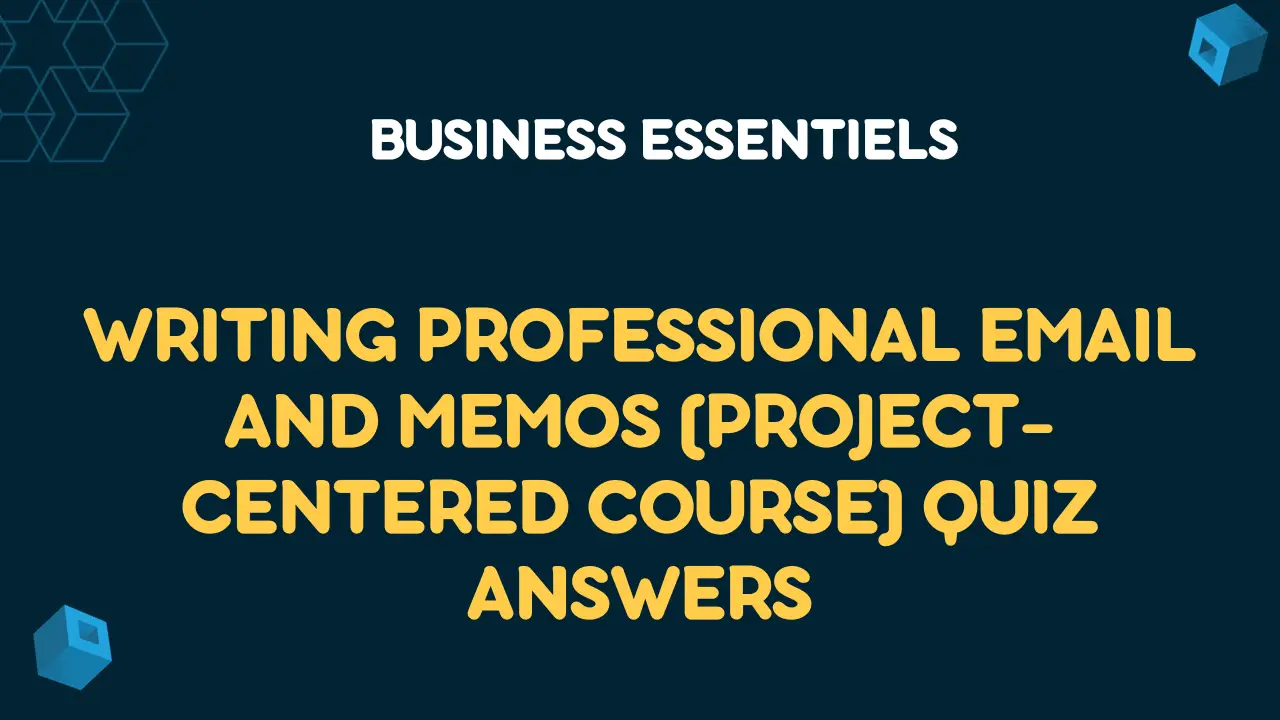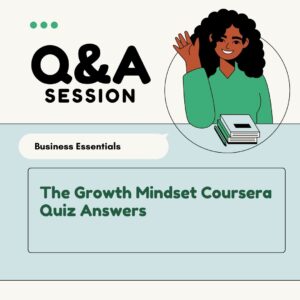Get All Weeks Writing Professional Email and Memos (Project-Centered Course) Quiz Answers
Table of Contents
Writing Professional Email and Memos (Project-Centered Course) Quiz Answers
Week 01 Quiz Answers
Q1. In what ways are the formats of emails and memos similar? Choose all that apply.
2.The type of information
Q2. What key pieces of information are provided by both memos and emails in the heading?
ViewQ3. Meeting minutes, directives, progress reports, and lab reports are all types of
ViewQ4. What is the best way to end a professional email?
ViewQ5. What is the meaning of “CC” in email?
ViewQ6. In which of these situations is it best to CC someone?
ViewQ7. When might you use BCC? Choose all that apply.
ViewQ8. Which is most true?
ViewWeek 02 Quiz Answers
Practice Quiz 01
Q1. Ms. Roberts: Hello Mr. Acworth! How are you today?
Mr. Acworth: Hello, Ms. Roberts. I’m not doing too well.
Ms. Roberts: Oh no? What’s wrong?
Mr. Acworth: Well, I was working yesterday, and Mr. Henry asked me to change some of the light bulbs. I climbed up on a chair to change the one in the atrium, and I fell.
Ms. Roberts:
ViewQ2. Ms. Sanchez: Hello everyone and welcome to the meeting. Our usual secretary, Mr. Johnson, couldn’t be here today. At this point, I’d like to ask if anyone will take
ViewQ3. Mr. Li: I’ve just received word that Mr. Sadler has had an asthma attack. He was entering the building, and he had to walk past a lot of people smoking. It triggered his asthma. He is going to the hospital now.
Ms. Majumder: Oh, no.You know, we should let people know about the new policy regarding smoking next to the building entrances.
Mr. Li: You are right. To let people know about the new policy, I should write and distribute a/an
ViewQ4. Mr. Abbasov received the following email: 
What should he do?
ViewQ5. Ms. Murphy: Hello Mr. Tanaka!
Mr. Tanaka: Hello, Ms. Murphy! How is that Devi project coming along?
Ms. Murphy: Funny you should ask. I was just about to send you
ViewPractice Quiz 02
Q1. In this course we will focus on five common email/memo types. Which type of email/memo, below, is NOT one we will focus on.
View- Incident reports
- Directives
- Meeting minutes
- Field reports
Q2. What is the appropriate way to sign a memo?
ViewQ3. One way to send a memo is to write it in memo format in a word processing program. Then, to send it electronically, you
ViewQ4. If you are sending a memo in memo format via email as an attachment, then you should
ViewQ5. In a progress report, one should: (choose all that apply)
View2.Describe what has been done so far.
3.Describe what is planned to do next.
4.Give information from project meetings.
Q6. A report that is broad and encompasses a range of activities within an organization is a
ViewQ7. Meeting minutes are
ViewQ8. When shared via email, meeting minutes might include this information (choose all that apply)
View2.Date of meeting
3.Times the meeting began and ended
4.Writer of the minutes
Q9. The statement, below, is not true of the meeting minutes
ViewQ10. The elements that must be included when filling out an incident report are (choose all that apply)
View2.Honesty
3.Clarity: plain speech with correct grammar and spelling
Q11. How do directives differ from general information emails/memos?
ViewQ12. In response to an inquiry, it is best to
ViewQ13. If there are multiple questions in an inquiry, some of which you do not know the answer to or cannot give the answer per company policy, you should
ViewQ14. If it is not your job to answer a question, you should
ViewQ15. The ability to feel another’s feelings as your own and write with another’s perspective in mind is
ViewWeek 03 Quiz Answers
Practice Quiz 01
Q1. What would you say is the MAIN problem with the email, below?

Q2. What would you say is the MAIN problem with the memo, below?
ViewQ3. There are several problems with the meeting minutes, below. What problems are there? Check all answers that apply.

2.tone and audience
Q4. Background: Reynaldo Smith works in the Geography Department at Kennesaw State University. Jaime Hutchinson is his department chair or supervisor. Jaime scheduled a meeting with her supervisor, Sabine Hofer, and Sabine’s assistant, Jim Kalinakis. She invited Reynaldo to that meeting to learn more about the university’s plans for the Online Geography degree, which Reynaldo is in charge of. Sabine, Jim, Reynaldo, and Jaime attended the meeting.
Question: Why is Jaime Hutchinson copied on the email exchange, below?
ViewQ5. The email exchange, below, is an inquiry and response to inquiry. What problem do you see with the response?
ViewPractice Quiz 02
Q1. Managing one’s impression requires paying attention to
View2.Grammar, spelling, and punctuation
3.Clarity and conciseness
4.Clarity and conciseness as well as grammar, spelling, and punctuation
Q2. . In considering the audience, one must think about (check all that apply)
View2.Who will read the email/memo without having all the context of being directly involved?
3.Who will use the information directly
4.Who may dislike or resist the information and how to soothe that
5.Who will file the email/memo and how he or she categorize it
6.Who is likely to skim and how to make sure he or she at least gets the gist of it
Q3. In emails, it is more important to be
ViewQ4. One should consider writing an email with _______ if writing to international clients.
ViewQ5. You are a new employee and are preparing to write your first memo in the company. This memo will be seen by your coworkers, your supervisors, and several people from other departments in the company. To determine the appropriate level of formality, you should _______.
ViewQ6. When is it okay to disregard formalities?
ViewQ7. In general, you should use headers in an email if it is longer than
ViewQ8. If you are not confident in your usage of punctuation, you should (check all that are correct)
View2.Learn the three most common comma rules.
Q9. Which of these practices is/are best for writing a good email? (Check the four correct answers)
View2.Take a break before a slow final read-through.
3.Identify the type.
4.Check to be sure you are being clear, concise, complete, and polite.
Get All Course Quiz Answers of Methods and Statistics in Social Sciences Specialization
Qualitative Research Methods Coursera Quiz Answers
Inferential Statistics Coursera Quiz Answers




